

WEEK 42: OCTOBER 11-17
TOPIC: TROJAN ASTEROIDS
In any orbital configuration involving two, and only two, objects – for example, Earth and the sun – the orbital motion can be solved directly from Isaac Newton’s Law of Universal Gravitation; the mathematical solution is complete and analytical. As soon as additional objects are added to the mix, however, things become much more complex, and as it turns out there is no analytical solution to a three-body, or any “n”-body, orbital configuration. Instead, the addition of the third object is usually treated as a “perturbation” to the original two-body solution, and the resulting orbital motion is solved – or, more accurately, approximated – numerically. In practice, the actual performance of these calculations can be tedious and laborious, although with the advent of modern computers over the past few decades this can be handled with relative ease.
The L1 through L3 points are on the same line as the line between the two primary objects. In the Earth-sun system, L1 is 1.6 million km directly sunward of Earth, L2 is the same distance in the opposite direction, i.e., beyond Earth, and L3 is just beyond Earth's orbit on the far side of the sun from Earth. L4 and L5,
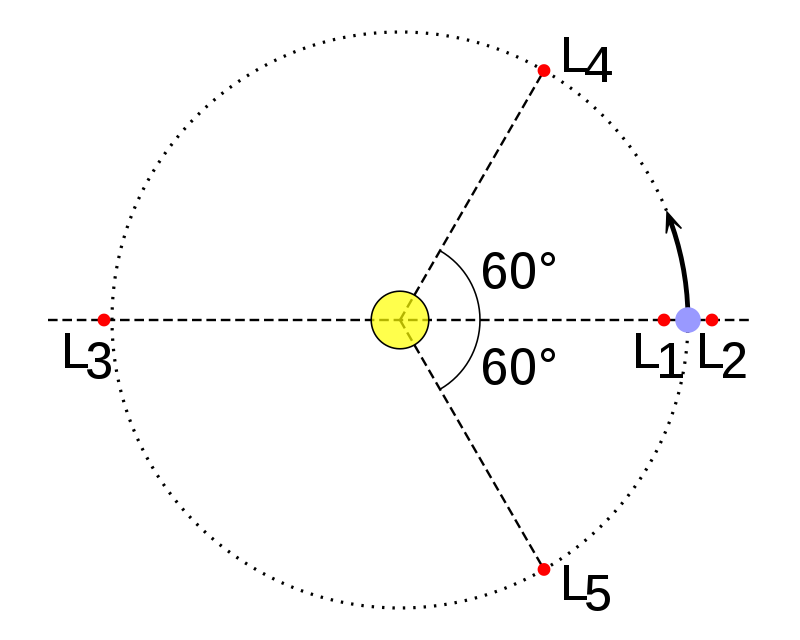
Several spacecraft have indeed been positioned at some of the Lagrangian points in the Earth-sun system. The NASA/ESA SOlar and Heliospheric Observatory (SOHO) spacecraft, which has discovered numerous comets and which is discussed in several other “Ice and Stone 2020” presentations, is at L1, as is NOAA’s Deep Space Climate ObserVatoRy (DSCOVR) mission, and as was the International Sun-Earth Explorer 3 (ISEE-3) spacecraft before it was sent to Comet 21P/Giacobini-Zinner (renamed as ICE) in the mid-1980s. Among other missions, ESA’s Herschel Space Telescope and Gaia spacecraft are at L2, as was China’s Chang’e 2 spacecraft before it was sent off to encounter the near-Earth asteroid (4179) Toutatis in 2012; the James Webb Space Telescope, now scheduled for launch in late 2021, will also be placed at L2.
In the Earth-moon system, the Kordylewski dust clouds – discussed in a previous “Special Topics” presentation -- are in and around the L4 and L5 points. The orbiting “space habitat” envisioned by the L5 Society – since merged into what is now the National Space Society – was, as the name implies, to be placed at the Earth-moon L5 point.
Since the L4 and L5 points in planets’ orbits are gravitationally stable, it would seem reasonable to think that natural objects, like asteroids, can exist in these locations. The American astronomer Edward Barnard, then based at Yerkes Observatory in Wisconsin, visually discovered the first-known such object near the Jupiter L5 point on the evening of September 12, 1904, which he at first mistakenly believed was Saturn’s recently-discovered outer moon Phoebe but which he later concluded was a different object; by that time, however, it was hopelessly “lost.” This object, which was later designated as 1904 RD, was finally found in late 1999 when Gareth Williams at the Minor Planet Center identified it (together with several other objects photographed on various occasions beginning in the mid-1970s) as being identical to the asteroid now known as (12126) 1999 RM11, which had been discovered in September of that year by the LINEAR program in New Mexico. Meanwhile, the German astronomer Max Wolf at Heidelberg Observatory discovered the first asteroid to be recognized as orbiting near a Jupiter-sun Lagrangian point when, on February 22, 1906, he found the asteroid now known as (588) Achilles orbiting near the L4 point. August Kopff, also at Heidelberg, discovered the asteroid now known as (617) Patroclus, orbiting near the Jupiter-sun L5 point, on October 17 of that same year, and then found (624) Hektor near the L4 point on February10 of the following year.
More and more such asteroids began to be discovered in subsequent years, and today over 7000 have been found, roughly 2/3 of these being in or around the L4 point. Current estimates are that there may be as many as several hundred thousand such objects down to a size of 1 km. Following the names given to the first-discovered representatives, these asteroids are collectively called “Trojan” asteroids and, per agreement within the astronomical community, they are given names of characters from the Trojan War as described in Homer’s Iliad and by other classical Greek authors. The asteroids around L4 are given names of Greek characters from that mythical conflict and those around L5 are given names of Trojan characters; since Patroclus and Hektor were named before this convention was established they are essentially “spies” within their “enemies’” camps.
(624) Hektor is the largest of the Trojan asteroids, with an approximate diameter of 225 km. (588) Achilles, (911) Agamemnon, and (3451) Mentor are all next, with approximate diameters in the range of 130 to 140 km, with additional known Trojans gradually becoming smaller. A handful of Trojans are known to have moons, the first-discovered such object being a companion to (617) Patroclus discovered in September 2001 by a team led by William Merline utilizing the 8.1-meter Gemini North telescope at Mauna Kea in Hawaii. This companion, since named Menoetius, almost makes a “double asteroid” system with Patroclus itself, the two objects having approximate diameters of 120 km (Patroclus) and 110 km (Menoetius) and separated by 680 km. (624) Hektor also has a moon, a much smaller (12 km) object discovered in 2006 by a team led by Franck Marchis utilizing the 10-meter Keck II telescope in Hawaii and since named Skamandrios. A team led by Keith Noll utilizing the Hubble Space Telescope discovered a small moon – probably no more that about 1 km in diameter – accompanying (3548) Eurybates in September 2018, and after confirming this object a year later announced its discovery earlier this year.
In physical terms, most of the Trojan asteroids that have been examined appear to be quite dark, with some exhibiting a somewhat reddish coloration and/or features in their spectra that are suggestive of organic compounds. There is evidence that at least some of the Trojans may be inactive comet nuclei, in fact a detailed study of Patroclus and Menoetius in 2006 suggests that their average density is less than that of water. Other Trojans, for example Hektor, appear to have a significantly higher density than this, so, perhaps not too surprisingly, the bodies making up the population of Trojan asteroids appear to have come from a wide variety of original objects.
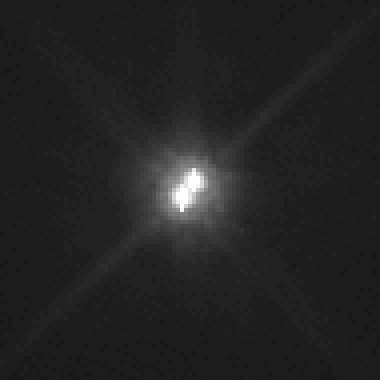
 LEFT: Hubble Space Telescope image of (617) Patroclus and its moon Menoetius taken February 13, 2018. Courtesy NASA/Southwest Research Institute. RIGHT: Artist’s conception of NASA’s Lucy mission (scheduled for launch in October 2021) during a flyby of a Jupiter Trojan asteroid. Courtesy NASA.
LEFT: Hubble Space Telescope image of (617) Patroclus and its moon Menoetius taken February 13, 2018. Courtesy NASA/Southwest Research Institute. RIGHT: Artist’s conception of NASA’s Lucy mission (scheduled for launch in October 2021) during a flyby of a Jupiter Trojan asteroid. Courtesy NASA.
We should get a much closer look at some of the Trojan asteroids with NASA’s Lucy mission, currently scheduled for launch in October 2021. As currently planned, Lucy will be visiting four Trojans around the L4 point – (3548) Eurybates (and its recently-discovered small moon), (15094) Polymele, (11351) Leucus, and (21900) Orus – between August 2027 and November 2028, then return to Earth for a gravity-assist flyby that will send it to the L5 point and an encounter with (617) Patroclus and its moon Menoetius in March 2033. Lucy is discussed in more detail in a previous “Special Topics” presentation.
Although the term “Trojan asteroid” has generally referred to objects orbiting the sun in or near Jupiter’s L4 or L5 points, it is appropriate to ask whether or not other planets also have their own sets of Trojan asteroids in their respective L4 and L5 locations. And the answer is “yes;” as of now, four other planets are now known to have Trojan asteroids, all of these objects having been discovered within the past three decades.
The first-known Neptune Trojan was 2001 QR322, discovered on August 21, 2001, by a survey effort called the Deep Ecliptic Survey, led by Robert Millis, from Cerro Tololo Inter-American Observatory in Chile; it orbits near the Neptune L4 point. Since then almost thirty additional Neptune Trojans have been found, most of these being around L4; only a handful have been found around the L5 point, and one more, (316179) 2010 EN65, is centered around Neptune’s L3 point but shifts back and forth between L4 and L5. The preponderance of objects near L4 is almost certainly due to an observational bias, since for the time being Neptune’s L5 region is located against the star-rich Milky Way area in Sagittarius. Distance also plays a role; even though the largest-known Neptune Trojans are close to 200 km in diameter, these are still no brighter than 19th or 20th magnitude.
With Neptune’s proximity to the Kuiper Belt it is likely that many of the Neptune Trojans are captured objects from that population. It is also quite possible that the total number of Neptune Trojans is several times that of the Jupiter Trojans, it’s just that the majority of these are too small, and thus too faint, to detect with most telescopes available nowadays.
Only a small handful of Neptune Trojans have been well enough observed to have permanent numbers assigned to them. By agreement amongst the international community of astronomers, Neptune Trojans will be assigned names of Amazon warriors, the all-female tribe who fought on the side of the Trojans during the Trojan War. As of right now, two of these objects have been so named: (385571) Otrera and (385695) Clete.
At this time only two Uranus Trojans have been discovered: 2011 QF99, discovered during the course of a survey program conducted with the Canada-France-Hawaii Telescope at Mauna Kea, and 2014 YX49, discovered by the Pan-STARRS survey; both are near the Uranus L4 point. Due to the proximity of both Neptune and Saturn and the resulting orbital resonance patterns, orbits near the Uranus L4 and L5 points are not stable over long periods of time, and thus both of these objects are only temporary Uranus Trojans. They and any other Uranus Trojans – past, present, and future – are likely Centaurs – discussed in a previous “Special Topics” presentation – that have been temporarily captured into that orbital configuration.
Saturn does not have any known Trojan asteroids although, curiously, two of its larger moons have “Trojan” moons at the L4 and L5 points of their respective orbits around Saturn. Tethys (diameter 1060 km) has Telesto (average diameter 25 km) at its L4 point and Calypso (average diameter 21 km) at L5, while Dione (diameter 1120 km) has Helene (average diameter 35 km) at its L4 point and the much smaller Polydeuces (average diameter 2.5 km) at L5.
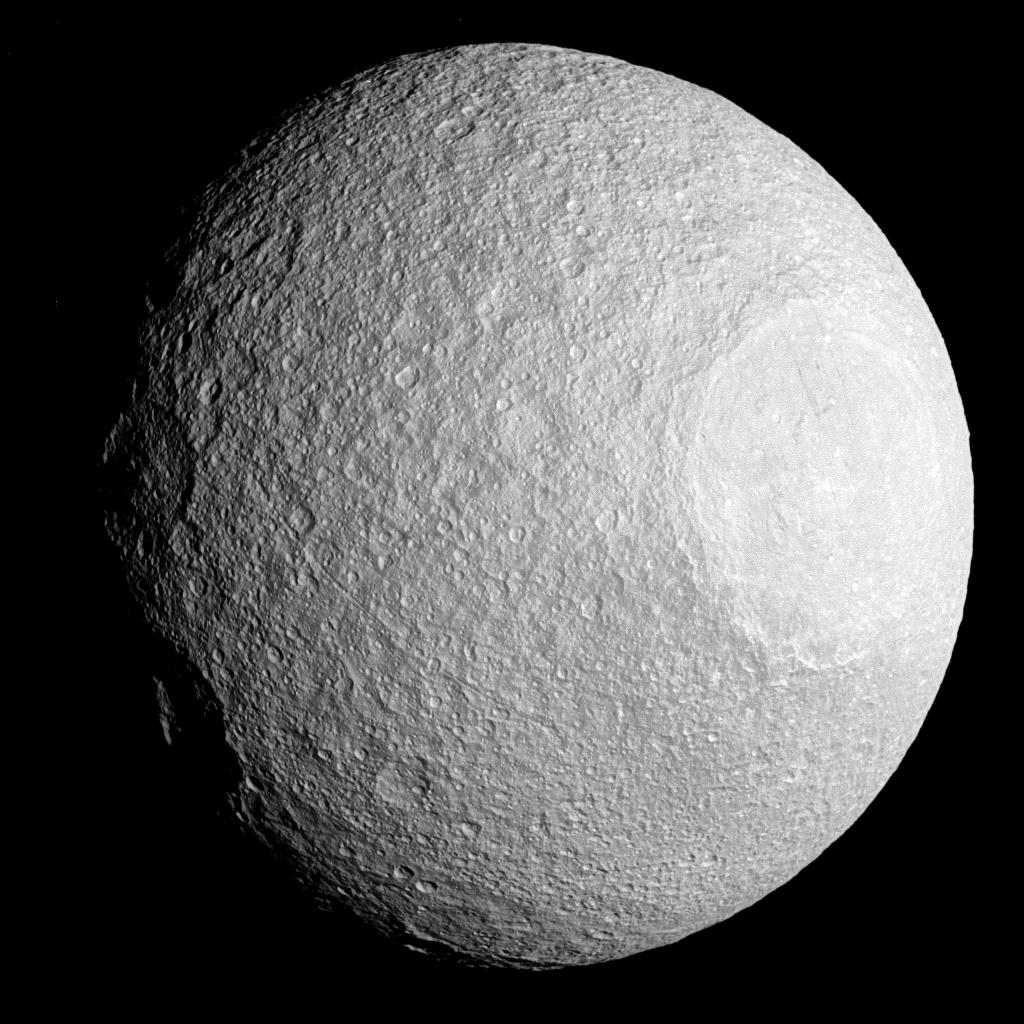
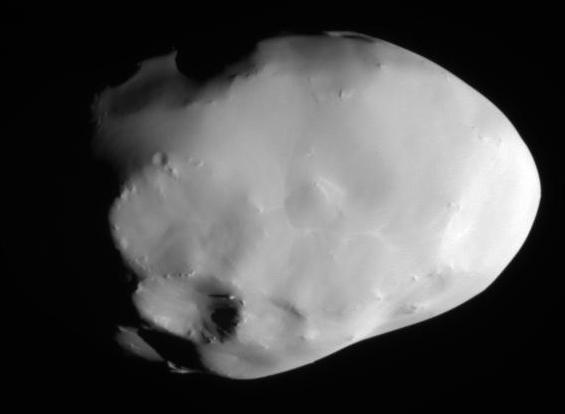
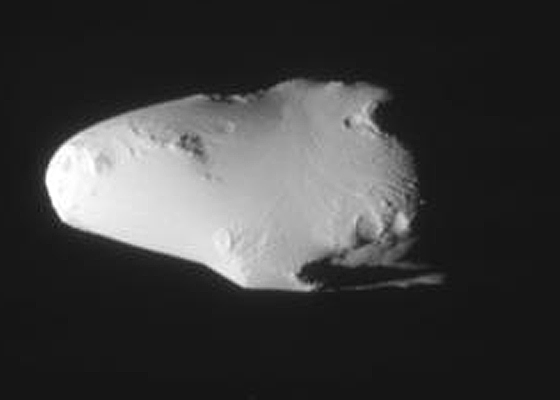 Cassini images of Saturn’s large moon Tethys and its two “Trojan” moons. Left: Tethys. The large crater on the right is Odysseus. Center: Telesto, at the Saturn-Tethys L4 point. Right: Calypso, at the Saturn-Tethys L5 point. All images courtesy NASA.
Cassini images of Saturn’s large moon Tethys and its two “Trojan” moons. Left: Tethys. The large crater on the right is Odysseus. Center: Telesto, at the Saturn-Tethys L4 point. Right: Calypso, at the Saturn-Tethys L5 point. All images courtesy NASA.
The first planet other than Jupiter known to have a Trojan asteroid was Mars when, on June 20, 1990, David Levy and Henry Holt, who were conducting the photographic survey program on the 46-cm Palomar Schmidt telescope in the absence of Eugene and Carolyn Shoemaker – this program being discussed in a previous “Special Topics” presentation – discovered the asteroid now known as (5261) Eureka near Mars’ L5 point. Since then a handful of additional objects have been discovered orbiting near Mars’ L5 point, two of which have been confirmed as being Mars Trojans, and one additional Mars Trojan, (121514) 1999 UJ7, has been found near the Mars L4 point.
(5261) Eureka is a relatively small object, with an approximate average diameter of 1.3 km, and the other Mars Trojans are even smaller, being 1 km in size or smaller. Eureka also apparently has a moon, designated as S/2011 (5261) 1, that was announced in 2014 based upon photometric measurements, and appears to be no more than 500 meters across. There is speculation that the smaller objects near L5 – and presumably Eureka’s moon as well – are fragments of Eureka that have been ejected over time due to its rapid rotation (its rotation period being 2.69 hours).
Following Eureka’s discovery and its determination as being a Mars Trojan, David Levy attempted to start a new tradition wherein such objects would be named after expressions of joy – Eureka! (“I have found it!”) supposedly having been uttered by the ancient Greek physicist Archimedes after he had just discovered what we now know as “Archimedes’ principle” wherein a body placed in water displaces a volume of water equivalent to its own mass. At this time, however, only five confirmed (or candidate) Mars Trojans have received permanent numbers and Eureka is the only one of these that has thus far received a name.

Any Trojan asteroids in Venus’ or Mercury’s orbits would be all but impossible to detect from Earth – unless, potentially, with space-based coronagraphs like those aboard the SOHO spacecraft, although no such objects have been detected. One object, 2013 ND15 – discovered by the Pan-STARRS survey in July 2013 but only observed for four weeks – is a potential temporary L4 Venus Trojan, although its orbital eccentricity of 0.61 carries it within Mercury’s orbit and outside Earth’s orbit. 2013 ND15 is a distinctly small object, no more than a few tens of meters in diameter, and since it experiences orbital resonances with Earth, Venus, and Mercury its present orbital configuration is not stable.
A 2011 study authored by Apostolos Christou in Northern Ireland and Paul Wiegert in Ontario identified several small main-belt asteroids as sharing the same orbits as the large asteroids (1) Ceres and (4) Vesta. Such orbits are unstable over long time-periods and thus any “Trojan” asteroids to these objects would only be temporary, although on the other hand there is a relatively large population of objects that could provide occupants for such orbits over long timescales. In any event, such analyses demonstrate that the solar system we see right now is a “snapshot” that only really applies to the here and now, and that things do change over the lifetime of the solar system.
“Special Topics” archive
Ice and Stone 2020 home page
Earthrise Institute home page
SPECIAL ADDENDUM
In light of the ever-increasing number of discoveries of Jupiter Trojan asteroids, the IAU has recently decided that these objects with absolute magnitudes (i.e., apparent magnitudes if viewed from heliocentric and geocentric distances of 1.0 AU at a phase angle of 0 degrees) fainter than 12 can be named for Olympic athletes.
The aforementioned recently-discovered moon of (3548) Eurybates has just been named “Queta,” after Norma Enriqueta Basilio Sotelo, who at the 1968 Olympic games in Mexico City became the first woman to light the Olympic flame.